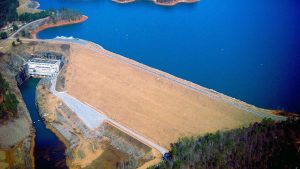Heather N. Kolich, ANR Agent, UGA Extension Forsyth County
Forsyth County is part of the Metropolitan North Georgia Water Planning District (Metro Water District), a pioneer organization in regional water planning that was established by the Georgia legislature in 2001. Since then, through the adoption water saving practices by industry, individuals and businesses, per capita water use in the 15-county region has dropped by 30 percent – enough to maintain water withdrawals at early 2000s levels even as our population increases daily.
Responsible water management is especially important for North Georgia because we rely primarily on surface water to supply our daily water needs. During drought episodes, lakes and rivers can drop to critically low levels. The drought of 1903-1905 was the first severe drought recorded in Georgia, but severe droughts and episodes of flooding are recurring events.

Buford Dam, which corrals the Chattahoochee River into Lake Lanier, was one of several Georgia dams constructed in the 1940s and 1950s under the Flood Control Act of 1944. Although its primary purposes were flood control and management of navigable waters, this 38,000-acre reservoir later became the major water source for Atlanta. Between water releases for downstream navigation and species protection and withdrawals to supply some 3 million customers with water, the lake came near to depletion during the historic drought of 2006-2008.
That drought was a pivotal event for water resource management and conservation in Georgia and spurred the creation of the Georgia Water Stewardship Act of 2010. The act required local governments, public water systems, and state agencies to take actions and/or implement policies to “create a culture of water conservation in the state of Georgia” and to report on the impacts of these new measures.
To encourage individuals to adopt water conservation practices, local governments and the Metro Water District used a combination of incentives and policy updates. Some big changes included sub-metering or individual tenant metering for multi-unit buildings such as apartments, office buildings, and light industrial facilities; implementation of tiered pricing for water usage, through which higher costs apply for higher volume usage; and restricting outdoor irrigation to the hours between 4 p.m. and 10 a.m.
Metro Water District offers rebates to customers of participating utilities for installing water leak detection devices and installing Ultra High Efficiency toilets (UHET). It also hosts the My Drop Counts challenge to encourage people to reduce water usage by 1,000 gallons per month at home or at work. Challenge participants pledge to adopt a variety of water conservation practices, such as mulching around trees, fixing leaking toilets and faucets, and turning off the water while brushing teeth or shaving. The pledge page reports that residential communities have committed to saving over 2 million gallons of water annually. Homeowners who want to do more can join the Society of Intentionally Dry Lawns, another program in My Drop Counts. Participants pledge to turn off lawn irrigation systems and water their lawn only as necessary – and they get a free yard sign. Visit https://northgeorgiawater.org/ to learn about rebate and pledge programs.
Georgia’s conservation achievements have earned national recognition from the Alliance for Water Efficiency, which named Georgia the 5th best state in the nation and the top state in the southeast for advancing water efficiency, conservation, and sustainability. To further improve water conservation efforts, new irrigation efficiency code requirements for metro counties went into effect on January 1, 2024. With this update, all new landscape irrigation systems must include enhanced water conservation components, such as a rain sensor shut-off, and adhere to specific design standards that help prevent water waste and runoff.